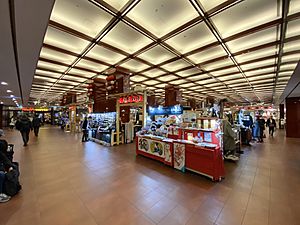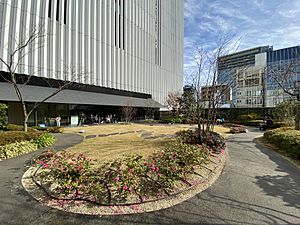Kabuki-za facts for kids

Kabuki-za, Tokyo's premier kabuki theater
|
|
| Address | 東京都中央区銀座四丁目12番15号 4-12-15 Ginza, Chūō-ku Tokyo Japan |
|---|---|
| Coordinates | 35°40′11″N 139°46′5″E / 35.66972°N 139.76806°E |
| Owner | Kabuki-za Theatrical Corporation |
| Operator | Shochiku |
| Type | Kabuki theater |
| Capacity | 1,964 |
| Construction | |
| Opened | 21 November 1889 |
| Rebuilt |
|
| Website | |
| http://www.kabuki-za.co.jp/ | |
The Kabuki-za (歌舞伎座) is a famous theater in Ginza, Tokyo, Japan. It is the main place to see traditional kabuki plays. Kabuki is a special kind of Japanese drama with singing, dancing, and elaborate costumes.
Contents
History of the Kabuki-za Theater
How the Kabuki-za Began
The Kabuki-za first opened its doors in 1889. It was started by a journalist named Fukuchi Gen'ichirō from the Meiji era (a period in Japanese history from 1868 to 1912). Fukuchi wrote kabuki plays, and famous actors like Ichikawa Danjūrō IX performed in them. After Danjūrō passed away in 1903, Fukuchi stopped managing the theater.
Ownership and Early Buildings
The theater is now run by the Shochiku Corporation, which took over in 1914. The very first Kabuki-za building was made of wood. It was built on land that once belonged to important Japanese families, like the Hosokawa clan.
Rebuilding After Disasters
The original wooden building was destroyed by an electrical fire on October 30, 1921. Work began in 1922 to rebuild it. The new design aimed to be fireproof while still looking like traditional Japanese architecture. It also used modern Western building materials and lighting.
However, the reconstruction was not finished when the theater burned down again during the terrible 1923 Great Kantō earthquake. The rebuilding was finally completed in 1924.
The Kabuki-za After World War II
The theater was destroyed once more during World War II due to Allied bombing. It was rebuilt in 1950, keeping the same style as the 1924 building. For many years, it was known as one of Tokyo's most traditional and impressive buildings.
The Latest Reconstruction (2010-2013)
The 1950 building was taken down in the spring of 2010. It was rebuilt over the next three years. The main reasons for this new reconstruction were worries about the building's safety during earthquakes and making it easier for everyone to access.
Before the old building was demolished, special "farewell performances" were held from January to April 2010. While the new theater was being built, kabuki shows took place at the nearby Shinbashi Enbujō and other locations. The brand new Kabuki-za complex officially opened on March 28, 2013.
Architecture and Design
The Kabuki-za's design, especially the 1924 version, was a mix of old Japanese styles. It looked like Japanese castles and temples from before the Edo period (1603-1868). This special style was kept when the theater was rebuilt after the war and again in 2013.
Inside the theater, the latest reconstruction added four new front curtains called doncho. These beautiful curtains were created by famous Japanese artists using the Nihonga style of painting. Each curtain shows a different season, adding to the theater's beauty.
Performances at Kabuki-za
How Shows Are Organized
All performances at the Kabuki-za are managed by Shochiku. The Kabuki-za Theatrical Corporation is the biggest owner of Shochiku. Shows happen almost every day. You can buy tickets for just one act of a play or for the entire show.
Monthly Programs
Like most kabuki theaters, the shows change every month. Each month, there is a specific set of plays and dances for the afternoon performance. A different set of plays makes up the evening show. These performances are repeated almost daily for about three to four weeks. Then, a new month brings a completely new program of shows.
Images for kids








